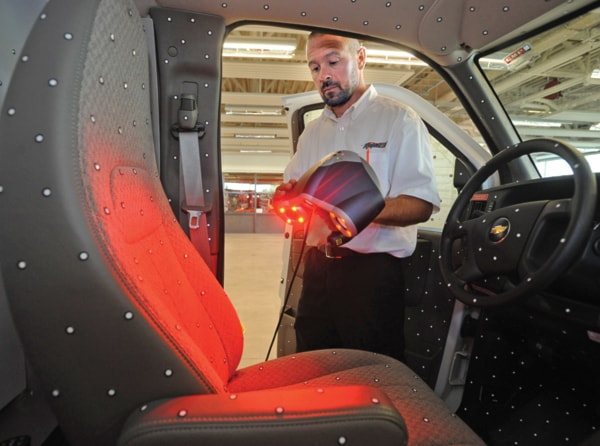An ambulance parked at Red Deer College’s Centre for Innovation in Manufacturing is undergoing a high-tech probing that could open the door to new manufacturing opportunities in Alberta.
The medical vehicle is the focal point of a three-day assessment of an advanced commercial software system called CATIA (Computer Aided Three-dimensional Interactive Application). A team of engineers is using laser scanners to create a three-dimensional computer model of the ambulance’s interior, which in turn should help improve the design to make it more user-friendly.
The project is a real one, being performed by Calgary’s Tangent Design Engineering Services for an ambulance operator. But it’s also being utilized to test CATIA.
Mark Burggren, technology development adviser with the Central Alberta Regional Innovation Network (CARIN), explained that a group of sponsors — including the Alberta Association of Colleges & Technical Institutes and the National Research Council — collaborated to bring the design software to Red Deer College.
“It’s an extraordinarily powerful solid modelling program, but it also gives the ability for designers and manufacturers and parts suppliers globally to be able to collaborate online in the design of a part,” said Burggren.
CATIA is used by the likes of The Boeing Company, Bombardier Aerospace, Chrysler, Ford and Toyota, and many other world-class manufacturers. Adopting the same system in Alberta could create opportunities for companies here to supply — or be supplied by — CATIA users elsewhere, he said.
“It’s one of the necessities for an economy like Alberta to move into these very sophisticated, large supply chains.”
The appeal of CATIA, said Burggren, is it helps ensure consistency and accuracy when parts and components for something like a petrochemical plant are produced at different locations.
“Using the same design software is a very, very important aspect of getting into large collaborative projects.”
Burggren and five engineers from companies participating in the ambulance project received CATIA training in June.
Ira Laughy, president of Rapid3D of Calgary, is leading the ambulance laser scanning exercise. He described how thousands of six-millimetre adhesive dots are being applied throughout The 3-D image ultimately created should be accurate to within about 0.5 millimetres, said Laughy, who demonstrated how it can be rotated and manipulated on his laptop computer.
Burggren noted that many Alberta designers currently use software like AutoCAD, Pro/ENGINEER and SolidWorks. CATIA would help push them to the next level.
“Looking out at what it will take for Alberta to continue and progress in this global economy, (the project sponsors) perceived that this was something that could help.”
Red Deer College’s Centre for Innovation in Manufacturing is already using laser scanners to create computer models from existing objects. The technology can also verify the dimensional accuracy of something like a prototype about to go into mass production.
Burggren expressed optimism that the CATIA trial will result in good things for the centre and for Alberta manufacturers.
“It’s a cool project, and where it goes from here, I don’t know. But I think it will head in the right direction.”
hrichards@www.reddeeradvocate.com
